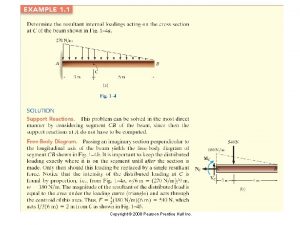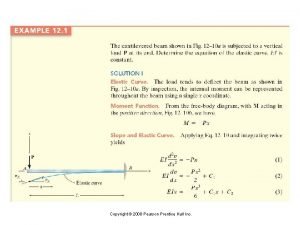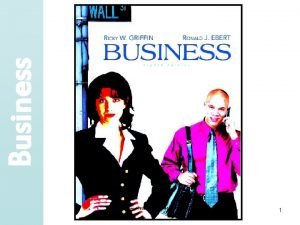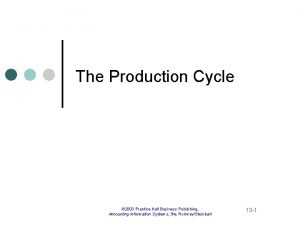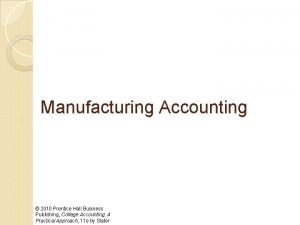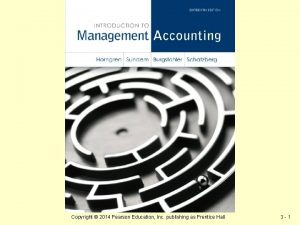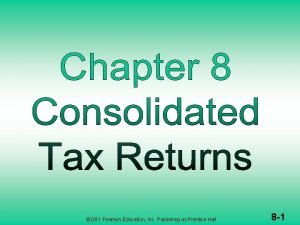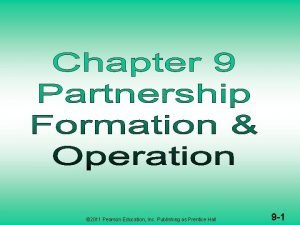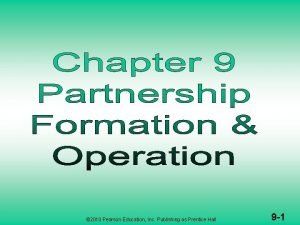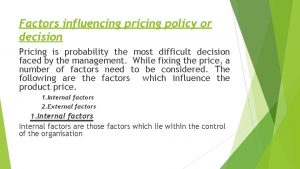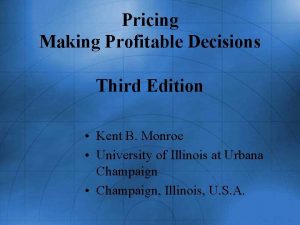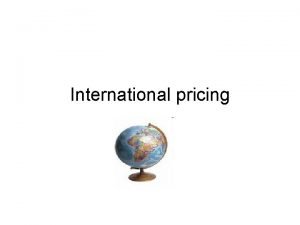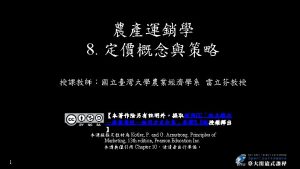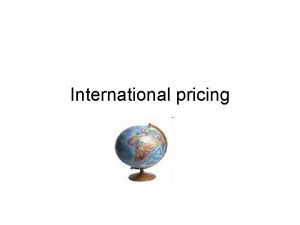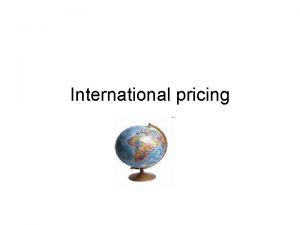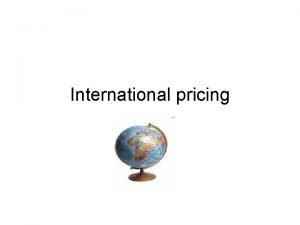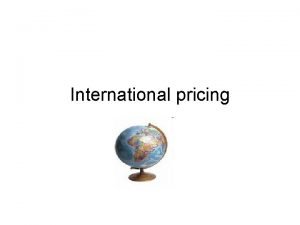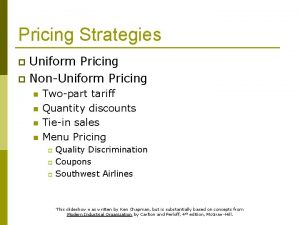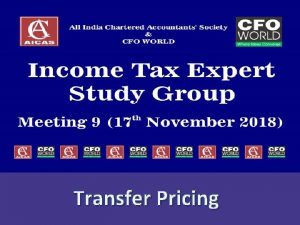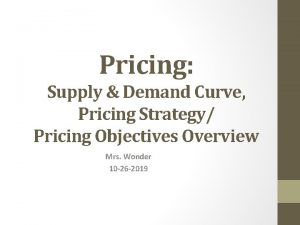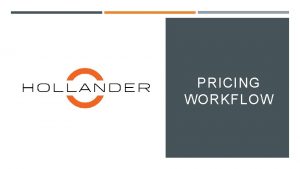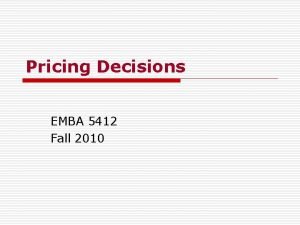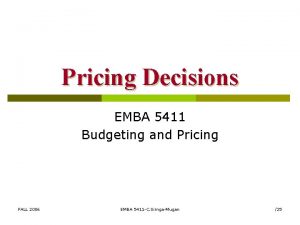Lesson 11 Pricing Decisions Prentice Hall 11 1


































- Slides: 34

Lesson 11 Pricing Decisions © Prentice Hall 11 -1

Pricing in the global market Theoretical perfect competition – one price everywhere ◦ Forex market, ICs, crude oil Country differences in price reflect ◦ Factor cost differences (e. g. labor costs) ◦ Level of competition (e. g. airfares in the US and India) ◦ Taxes (different sales tax structures) ◦ Internet brings transparency to prices (e. g. music / software sold on the net) ◦ Life cycle stage (introductory stage products vs. maturity products) 11 -2

Global Pricing Objectives and Strategies Managers must determine the objectives for the pricing objectives ◦ Increasing Unit Sales ◦ Capturing Market Share ◦ Increasing Return on investment (profits) They must then develop strategies to achieve those objectives ◦ Penetration Pricing ◦ Market Skimming 11 -3

Market Skimming and Financial Objectives Market Skimming ◦ Charging a premium price ◦ Introduction stage of product life cycle ◦ “make hay while the sun shines”- Suitable for products which obsolete fast ◦ Innovations / Inventions Sony Ad. for camcorders 11 -4

Penetration Pricing and Non-Financial Objectives Penetration Pricing ◦ Charging a low price in order to penetrate market quickly ◦ Appropriate to saturate market prior to imitation by competitors 1979 Sony Walkman 11 -5

Companion Products whose sale is dependent upon the sale of primary product ◦ Video games are dependent upon the sale of the game Console “If you make money on the blades you can give away the razors. ” X-Box Game System and Sports Game 11 -6

Setting prices - baselines Direct and Indirect costs (breakeven prices) Market prices “What the traffic can bear” Pricing objectives 11 -7

Target Costing – 8 Questions 1. Does the price reflect the product’s quality? 2. Is the price competitive given local market conditions? 3. Should the firm pursue market penetration, market skimming, or some other pricing objective? 4. What type of discount (trade, cash, quantity) and allowance (advertising, tradeoff) should the firm offer its international customers? 5. Should prices differ with market segment? 6. What pricing options are available if the firm’s costs increase or decrease? Is demand in the international market elastic or inelastic? 7. Are the firm’s prices likely to be viewed by the host-country government as reasonable or exploitative? 8. Do the foreign country’s dumping laws pose a problem? 11 -8

Target Costing Cost-Based Pricing is based on an analysis of internal and external cost Firms using western cost accounting principles use the Full absorption cost method ◦ Per-unit product costs are the sum of all past or current direct and indirect manufacturing and overhead costs 11 -9

Target Costing Rigid cost-plus pricing means that companies set prices without regard to the eight foundational pricing considerations Flexible cost-plus pricing ensures that prices are competitive in the context of the particular market environment 11 -10

Terms of the Sale Obtain export license if required Obtain currency permit Pack goods for export Transport goods to place of departure Prepare a land bill of lading Complete necessary customs export papers Prepare customs or consular invoices Arrange for ocean freight and preparation Obtain marine insurance and certificate of the policy 11 -11

Terms of the Sale Incoterms ◦ Ex-works – seller places goods at the disposal of the buyer at the time specified in the contract; buyer takes delivery at the premises of the seller and bears all risks and expenses from that point on. ◦ Delivery duty paid – seller agrees to deliver the goods to the buyer at the place he or she names in the country of import with all costs, including duties, paid. 11 -12

Incoterms FAS (free alongside ship) named port of destination – seller places goods alongside the vessel or other mode of transport and pays all charges up to that point FOB (free on board) – seller’s responsibility does not end until goods have actually been placed aboard ship CIF (cost, insurance, freight) named port of destination – risk of loss or damage of goods is transferred to buyer once goods have passed the ship’s rail CFR (cost and freight) – seller is not responsible at any point outside of factory Return 11 -13

Environmental Influences on Pricing Decisions Currency Fluctuations Inflationary Environment Government Controls, Subsidies, Regulations Competitive Behavior Sourcing 11 -14

Currency Fluctuations Return 11 -15

Inflationary Environment Defined as a persistent upward change in price levels ◦ Can be caused by an increase in the money supply ◦ Can be caused by currency devaluation Essential requirement for pricing is the maintenance of operating margins Return 11 -16

Government Controls, Subsidies, and Regulations The types of policies and regulations that affect pricing decisions are: ◦ ◦ Dumping legislation Resale price maintenance legislation Price ceilings General reviews of price levels Return 11 -17

Competitive Behavior If competitors do not adjust their prices in response to rising costs it is difficult to adjust your pricing to maintain operating margins If competitors are manufacturing or sourcing I a lower-cost country, it may be necessary to cut prices to stay competitive Return 11 -18

Using Sourcing as a Strategic Pricing Tool Marketers of domestically manufactured finished products may move to offshore sourcing of certain components to keep costs down and prices competitive Can you stay competitive while staying local? Return 11 -19

Global Pricing: Three Policy Alternatives Extension Adaptation Geocentric 11 -20

Extension Ethnocentric Per-unit price of an item is the same no matter where in the world the buyer is located (e. g. Mattel toys, Mercedes cars) Importer must absorb freight and import duties Fails to respond to each national market Return 11 -21

Adaptation Polycentric Permits affiliate managers or independent distributors to establish price as they feel is most desirable in their circumstances Sensitive to market conditions but creates potential for gray marketing E. g. prices of books, drugs, etc. Return 11 -22

Gray Market Goods Trademarked products are exported from one country to another where they are sold by unauthorized persons or organizations Occurs when product is in short supply, when producers use skimming strategies in some markets, and when goods are subject to substantial mark-ups 11 -23

Geocentric Intermediate course of action Recognizes that several factors are relevant to pricing decision ◦ Local costs (lower costs may justify lower prices) ◦ Income levels (high income levels may justify higher prices) ◦ Competition ◦ Local marketing strategy Return 11 -24

Examples Givenchy introduces a new high fashion product (e. g. formal gowns). Typical PLC is about a year. ◦ In the US ◦ In India ◦ In France Pfizer introduces a new patented drug ◦ In US ◦ In China 11 -25

Examples Toyota introduces a new economy sub-compact car ◦ In US ◦ In UK ◦ In Japan Ford introduces a fuel cell car ◦ In US ◦ In India ◦ In Saudi Arabia 11 -26

Examples Boeing introduces the 7 E 7 to ◦ Air France ◦ Singapore Airlines ◦ Delta Airlines Motorola introduces the Razor (cell phone) ◦ In US ◦ In India 11 -27

Dumping Sale of an imported product at a price lower than that normally charged in a domestic market or country of origin. Occurs when imports sold in the US market are priced at either levels that represent less than the cost of production plus an 8% profit margin or at levels below those prevailing in the producing countries To prove, both price discrimination and injury must be shown 11 -28

Price Fixing Representatives of two or more companies secretly set similar prices for their products ◦ Illegal act because it is anticompetitive Horizontal price fixing occurs when competitor within an industry that make and market the same product conspire to keep prices high e. g. ADM and enzyme used in animal feed. Vertical price fixing occurs when a manufacture conspires with wholesalers/retailers to ensure certain retail prices are maintained. E. g. De. Beers industrial diamonds. 11 -29

Transfer Pricing of goods, services, and intangible property bought and sold by operating units or divisions of a company doing business with an affiliate in another jurisdiction Cross-border exchanges constitute a sale Intra-corporate exchanges ◦ Cost-based transfer pricing ◦ Market-based transfer pricing ◦ Negotiated transfer pricing 11 -30

Countertrade occurs when payment is made in some form other than money e. g. when hard currency is scarce. Options ◦ Barter (e. g. Pepsico and Stolichnaya imports from USSR in exchange for concentrate) ◦ Counter-purchase (money exchange involved but transaction not complete unless a separate purchase is also made – e. g. Rockwell / Zimbabwe) 11 -31

Countertrade ◦ Offset (LDCs request exporters to buy the LDCs products in an effort to regain scarce forex e. g. Boeing and China) ◦ Compensation trading (also called buyback – e. g. supplier building a plant in exchange for buying back a certain percentage of its output for several years, as payment for the plant) ◦ Switch trading (third party steps in to take unwanted goods at a fee) 11 -32

Office of National Statistics Inflation and price indices The rate of increase in prices for goods and services. Measures of inflation and prices include consumer price inflation, producer price inflation, the house price index, index of private housing rental prices, and construction output price indices. https: //www. ons. gov. uk/economy/inflationandpriceindices 11 -33

Historical UK inflation rates and calculator Historical prices can be converted into equivalent present-day prices by using historical inflation rates. Use the calculator below to convert prices between any year in the range 1751 to 2017. http: //inflation. iamkate. com/ 11 -34
 Meaning of poster making
Meaning of poster making 2008 pearson prentice hall inc
2008 pearson prentice hall inc Pearson prentice hall
Pearson prentice hall 2008 pearson prentice hall inc
2008 pearson prentice hall inc 2005 pearson prentice hall inc
2005 pearson prentice hall inc Pearson prentice hall
Pearson prentice hall Prentice hall inc
Prentice hall inc Prentice hall careers
Prentice hall careers Prentice hall america pathways to the present
Prentice hall america pathways to the present 2011 pearson education inc
2011 pearson education inc Prentice hall publishing
Prentice hall publishing Prentice hall african american history
Prentice hall african american history Pearson physical science concepts in action answers
Pearson physical science concepts in action answers Pearson education inc publishing as pearson prentice hall
Pearson education inc publishing as pearson prentice hall Ocean fisheries
Ocean fisheries Pearson prentice hall
Pearson prentice hall 2005 pearson prentice hall inc
2005 pearson prentice hall inc Pearson education inc publishing as pearson prentice hall
Pearson education inc publishing as pearson prentice hall Arthropoda common name
Arthropoda common name Prentice hall business publishing
Prentice hall business publishing Pearson education inc. publishing as prentice hall
Pearson education inc. publishing as prentice hall 2012 pearson education inc
2012 pearson education inc Pearson education inc. 2012
Pearson education inc. 2012 Prentice hall jobs
Prentice hall jobs 2011 pearson education inc
2011 pearson education inc 2011 pearson education inc
2011 pearson education inc Pearson education inc. publishing as prentice hall
Pearson education inc. publishing as prentice hall Pearson education inc. publishing as prentice hall
Pearson education inc. publishing as prentice hall Screening decisions and preference decisions
Screening decisions and preference decisions Factors influencing international pricing
Factors influencing international pricing Pricing and output decisions in perfect competition
Pricing and output decisions in perfect competition Pricing decisions and cost management
Pricing decisions and cost management Pricing: making profitable decisions
Pricing: making profitable decisions Lesson 2 making responsible decisions and setting goals
Lesson 2 making responsible decisions and setting goals Lesson 2 making responsible decisions and setting goals
Lesson 2 making responsible decisions and setting goals


